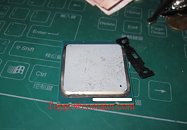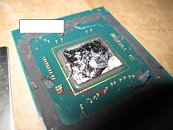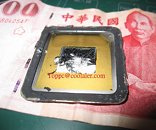- Joined
- Oct 9, 2007
- Messages
- 47,614 (7.45/day)
- Location
- Dublin, Ireland
| System Name | RBMK-1000 |
|---|---|
| Processor | AMD Ryzen 7 5700G |
| Motherboard | Gigabyte B550 AORUS Elite V2 |
| Cooling | DeepCool Gammax L240 V2 |
| Memory | 2x 16GB DDR4-3200 |
| Video Card(s) | Galax RTX 4070 Ti EX |
| Storage | Samsung 990 1TB |
| Display(s) | BenQ 1440p 60 Hz 27-inch |
| Case | Corsair Carbide 100R |
| Audio Device(s) | ASUS SupremeFX S1220A |
| Power Supply | Cooler Master MWE Gold 650W |
| Mouse | ASUS ROG Strix Impact |
| Keyboard | Gamdias Hermes E2 |
| Software | Windows 11 Pro |
Coolaler.com community member "Toppc" scored an engineering sample of Intel's upcoming Core i7-4960X "Ivy Bridge-E" socket LGA2011 processor, and wasted no time in taking a peek inside its integrated heatspreader (IHS). Beneath the adhesive layer that holds the IHS to the package, which could be fairly easily cut through, "Toppc" discovered that Intel is using a strong epoxy/solder to fuse the processor's die to the IHS, and not a thermal paste, like on Core i7-3770K. Solders tend to have better conductivity than pastes, but make it extremely difficult to de-lid the processors, not to mention potentially disastrous. In the process of delidding this chip, "Toppc" appears to have knocked out a few components around the die. Unless you're good at precision soldering, something like that would be a fatal blow to your $1000 investment.



View at TechPowerUp Main Site



View at TechPowerUp Main Site






